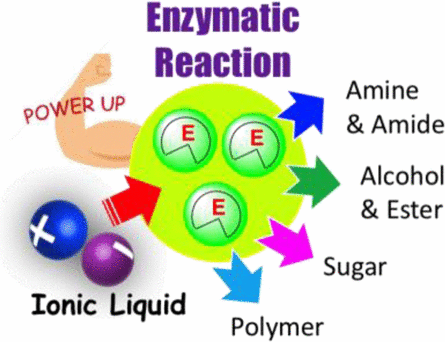当前位置:
X-MOL 学术
›
Chem. Rev.
›
论文详情
Our official English website, www.x-mol.net, welcomes your feedback! (Note: you will need to create a separate account there.)
Ionic Liquids as Tool to Improve Enzymatic Organic Synthesis
Chemical Reviews ( IF 62.1 ) Pub Date : 2017-07-26 00:00:00 , DOI: 10.1021/acs.chemrev.7b00158 Toshiyuki Itoh 1
Chemical Reviews ( IF 62.1 ) Pub Date : 2017-07-26 00:00:00 , DOI: 10.1021/acs.chemrev.7b00158 Toshiyuki Itoh 1
Affiliation

|
Ionic liquids (ILs) have now been acknowledged as reaction media for biotransformations. The first three examples were reported in this field in 2000, and since then, numerous applications have been reported for biocatalytic reactions using ILs. Two topics using ILs for enzymatic reactions have been reviewed from the standpoint of biocatalyst mediating organic synthesis; the first is “Biocatalysis in Ionic Liquids” which includes various types of biocatalytic reactions in ILs (section 2): (1) recent examples of lipase-mediated reactions using ILs as reaction media for biodiesel oil production and for sugar ester production, (2) oxidase-catalyzed reactions in ILs, (3) laccase-catalyzed reactions, (4) peroxidase-catalyzed reactions, (4) cytochrome-mediated reactions, (5) microbe-mediated hydrations, (6) protease-catalyzed reactions, (8) whole cell mediated asymmetric reduction of ketones, (10) acylase-catalyzed reactions, (11) glycosylation or cellulase-mediated hydrolysis of polysaccharides, (12) hydroxynitrile lyase-catalyzed reaction, (13) fluorinase or haloalkane dehydrogenase-catalyzed reaction, (14) luciferase-catalyzed reactions, and (15) biocatalytic promiscuity of enzymatic reactions for organic synthesis using ILs. The second is “Enzymes Activated by Ionic Liquids for Organic Synthesis”, particularly describing the finding story of activation of lipases by the coating with a PEG-substituted IL (section 3). The author’s opinion toward “Future Perspectives of Using ILs for Enzymatic Reactions” has also been discussed in section 4.
中文翻译:

离子液体作为改善酶促有机合成的工具
现已认识到离子液体(ILs)作为生物转化的反应介质。前三个例子是2000年在该领域报道的,此后,已经报道了许多使用IL进行生物催化反应的应用。从生物催化剂介导有机合成的角度,已经综述了使用ILs进行酶促反应的两个主题。第一个是“离子液体中的生物催化”,其中包括IL中各种类型的生物催化反应(第2节):(1)使用IL作为生产生物柴油和糖酯的反应介质的脂肪酶介导反应的最新实例,(2 )IL中的氧化酶催化反应,(3)漆酶催化反应,(4)过氧化物酶催化反应,(4)细胞色素介导的反应,(5)微生物介导的水合,(6)蛋白酶催化的反应,(8)全细胞介导的酮的不对称还原,(10)酰基转移酶催化的反应,(11)糖基化或纤维素酶介导的多糖水解,(12)羟基腈裂解酶催化的反应,(13)氟化酶或卤代烷脱氢酶催化的反应,(14)萤光素酶催化的反应和(15)使用IL进行有机合成的酶促反应的生物催化混杂性。第二个是“离子液体激活的用于有机合成的酶”,特别描述了用PEG取代的IL包被涂层激活脂肪酶的发现故事(第3节)。作者对“将IL用于酶促反应的未来观点”的观点也已在第4节中进行了讨论。(11)多糖的糖基化或纤维素酶介导的水解,(12)羟腈裂解酶催化的反应,(13)氟化酶或卤代烷脱氢酶催化的反应,(14)萤光素酶催化的反应,以及(15)酶促反应的生物催化混杂性使用IL进行有机合成。第二个是“离子液体激活的用于有机合成的酶”,特别描述了用PEG取代的IL包被涂层激活脂肪酶的发现故事(第3节)。作者对“将IL用于酶促反应的未来观点”的观点也已在第4节中进行了讨论。(11)多糖的糖基化或纤维素酶介导的水解,(12)羟腈裂解酶催化的反应,(13)氟化酶或卤代烷脱氢酶催化的反应,(14)萤光素酶催化的反应,以及(15)酶促反应的生物催化混杂性使用IL进行有机合成。第二个是“由离子液体激活的用于有机合成的酶”,特别描述了通过涂有PEG取代的IL的涂层激活脂肪酶的发现故事(第3节)。作者对“将IL用于酶促反应的未来观点”的观点也已在第4节中进行了讨论。(15)使用IL进行有机合成的酶促反应的生物催化混杂性。第二个是“离子液体激活的用于有机合成的酶”,特别描述了用PEG取代的IL包被涂层激活脂肪酶的发现故事(第3节)。作者对“将IL用于酶促反应的未来观点”的观点也已在第4节中进行了讨论。(15)使用IL进行有机合成的酶促反应的生物催化混杂性。第二个是“离子液体激活的用于有机合成的酶”,特别描述了用PEG取代的IL包被涂层激活脂肪酶的发现故事(第3节)。作者对“将IL用于酶促反应的未来观点”的观点也已在第4节中进行了讨论。
更新日期:2017-07-26
中文翻译:

离子液体作为改善酶促有机合成的工具
现已认识到离子液体(ILs)作为生物转化的反应介质。前三个例子是2000年在该领域报道的,此后,已经报道了许多使用IL进行生物催化反应的应用。从生物催化剂介导有机合成的角度,已经综述了使用ILs进行酶促反应的两个主题。第一个是“离子液体中的生物催化”,其中包括IL中各种类型的生物催化反应(第2节):(1)使用IL作为生产生物柴油和糖酯的反应介质的脂肪酶介导反应的最新实例,(2 )IL中的氧化酶催化反应,(3)漆酶催化反应,(4)过氧化物酶催化反应,(4)细胞色素介导的反应,(5)微生物介导的水合,(6)蛋白酶催化的反应,(8)全细胞介导的酮的不对称还原,(10)酰基转移酶催化的反应,(11)糖基化或纤维素酶介导的多糖水解,(12)羟基腈裂解酶催化的反应,(13)氟化酶或卤代烷脱氢酶催化的反应,(14)萤光素酶催化的反应和(15)使用IL进行有机合成的酶促反应的生物催化混杂性。第二个是“离子液体激活的用于有机合成的酶”,特别描述了用PEG取代的IL包被涂层激活脂肪酶的发现故事(第3节)。作者对“将IL用于酶促反应的未来观点”的观点也已在第4节中进行了讨论。(11)多糖的糖基化或纤维素酶介导的水解,(12)羟腈裂解酶催化的反应,(13)氟化酶或卤代烷脱氢酶催化的反应,(14)萤光素酶催化的反应,以及(15)酶促反应的生物催化混杂性使用IL进行有机合成。第二个是“离子液体激活的用于有机合成的酶”,特别描述了用PEG取代的IL包被涂层激活脂肪酶的发现故事(第3节)。作者对“将IL用于酶促反应的未来观点”的观点也已在第4节中进行了讨论。(11)多糖的糖基化或纤维素酶介导的水解,(12)羟腈裂解酶催化的反应,(13)氟化酶或卤代烷脱氢酶催化的反应,(14)萤光素酶催化的反应,以及(15)酶促反应的生物催化混杂性使用IL进行有机合成。第二个是“由离子液体激活的用于有机合成的酶”,特别描述了通过涂有PEG取代的IL的涂层激活脂肪酶的发现故事(第3节)。作者对“将IL用于酶促反应的未来观点”的观点也已在第4节中进行了讨论。(15)使用IL进行有机合成的酶促反应的生物催化混杂性。第二个是“离子液体激活的用于有机合成的酶”,特别描述了用PEG取代的IL包被涂层激活脂肪酶的发现故事(第3节)。作者对“将IL用于酶促反应的未来观点”的观点也已在第4节中进行了讨论。(15)使用IL进行有机合成的酶促反应的生物催化混杂性。第二个是“离子液体激活的用于有机合成的酶”,特别描述了用PEG取代的IL包被涂层激活脂肪酶的发现故事(第3节)。作者对“将IL用于酶促反应的未来观点”的观点也已在第4节中进行了讨论。



























 京公网安备 11010802027423号
京公网安备 11010802027423号